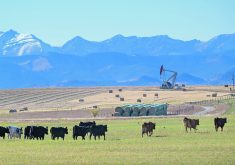Industry expects to require 15 million litres by 2024, but it’s not certain there will be enough feedstock to get the job done
The renewable diesel industry has a looming feedstock problem, says an analyst.
The Energy Information Administration is forecasting 11 to 19 billion litres of renewable diesel capacity in the United States by 2024, up from 3.8 billion litres today.
Using the mid-range of the forecast, that is 15 billion litres of capacity that will be required to meet low carbon fuel standards in states such as California.
It would in turn require 32 billion pounds of feedstock oil annually, up from the eight billion lb. being used by the renewable diesel sector today, said Bill Lapp, founder of Advanced Economic Solutions.
Read Also

USDA’s August corn yield estimates are bearish
The yield estimates for wheat and soybeans were neutral to bullish, but these were largely a sideshow when compared with corn.
That is an extra 24 billion lb. of feedstock that will be required in just two short years.
To put that in perspective, the total amount of all fats and oils used in the U.S. today is 59 billion lb.
There is some help on the way with a plethora of new soybean and canola crushing plants being built in the U.S. and Canada, but that won’t provide nearly enough feedstock to meet the looming new source of demand for fats and oils.
Other measures can be taken to divert existing supplies of fats and oils or import from other countries, but there will still likely be a gap.
“When you add them all up, you can’t get to 24 billion lb.,” said Lapp.
The upshot is that the feedstock shortage may result in a reining in of the ambitious renewable diesel capacity target.
“Maybe we simply fall short of that four billion gallons (15 billion litres), even though it has been announced by some very large players,” he said.
Bunge chief executive officer Greg Heckman also indicated that it will be a challenge to find adequate amounts of feedstock for the renewable diesel sector when asked about it during the company’s recent conference call on its fourth quarter 2021 financial results.
“I think it’s going to take kind of everything to supply that industry and the demand that is coming from that industry,” he said, according to a Seeking Alpha transcript of the call.
“We’ll see the U.S. go from being an exporter to an importer of vegetable oils.”
He expects to see new seed technology that will increase the percent of oil content in soybeans, the increased adoption of oilseed cover crops and higher capacity utilization of existing crush plants.
Heckman said Bunge is well positioned to take advantage of the explosive growth in the renewable diesel sector through its joint venture with Chevron.
Bunge is contributing its soybean crush plants in Destrehan, Louisiana and Cairo, Illinois, to the venture, while Chevron is ponying up US$600 million in cash.
Bunge intends to double the combined crush capacity of the two plants to 14,000 tons of oil per day by the end of 2024. Chevron will have the purchase rights to that soybean oil.
Chevron expects to build plants with the capacity to produce 100,000 barrels per day of renewable diesel and sustainable aviation fuel by 2030.
Lapp said the first place to look for feedstock help is the U.S. soybean sector, where companies have announced plans to build an additional 400 million bushels of annual crush capacity.
“That will be part of the solution but it will not be the sole solution,” he said during his presentation at the USDA’s 98th annual Agricultural Outlook Forum.
If all of that proposed new capacity gets built, the plants would produce an additional 4.5 billion lb. of soybean oil annually.
It would also create an additional seven million tonnes of soybean meal that would need to find a home and would result in either a reduction in U.S. soybean exports or the need for an additional eight million acres of the oilseed.
The next most obvious source of feedstock is Canada’s canola sector, where crush capacity is expanding to 16 million tonnes annually from 11 million tonnes.
That will add another 4.6 billion lb. of vegetable oil feedstock to the mix.
However, a portion of that additional production will likely go to the food sector. He also noted that Canada could create its own low carbon fuel standards that may keep the feedstock north of the border.
Another option is to reduce the use of fats and distillers corn oil in feed rations. An estimated three billion lb. of tallow, used cooking oil and distillers corn oil are used as animal feed each year in the U.S.
There may be an increase in the supply of used cooking oil, but it is expensive to gather and transport.
Renewable diesel manufacturers could also import feedstock from other countries, but again, that is an expensive alternative.


















